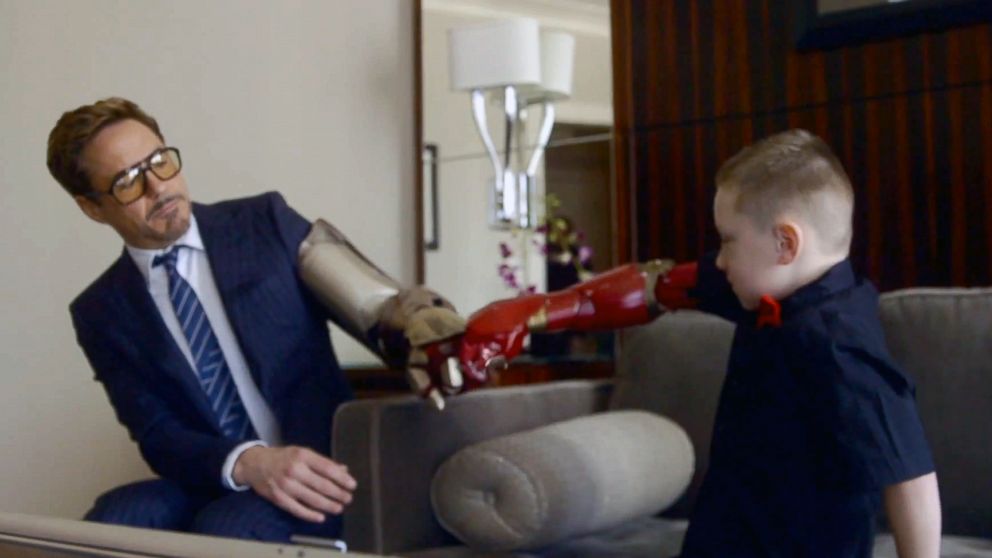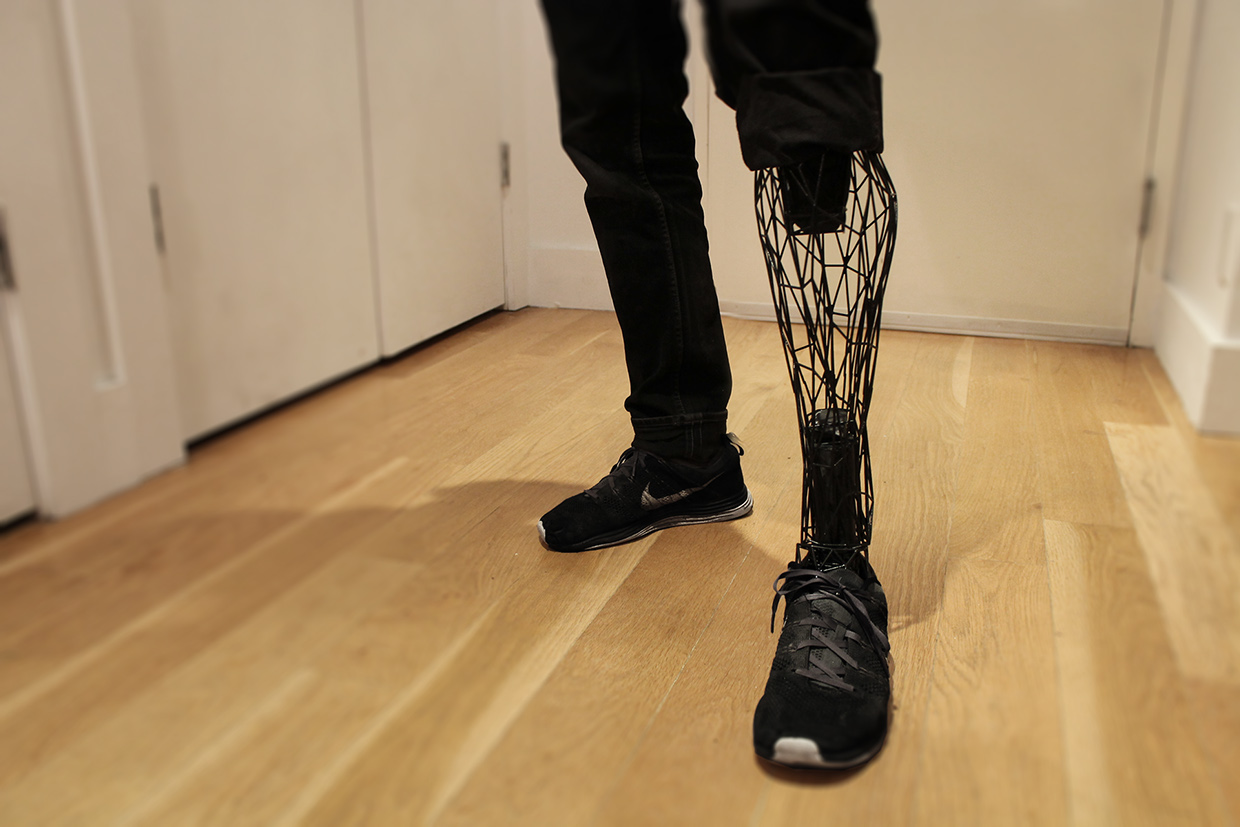Have you already seen that popular video? It popped up
a few days ago and the internet
users went crazy about it!
The video shows a limbless 6 year old who gets a bionic arm. Not just “an arm”, but the
one inspired by the Iron Man’s suit, and presented to him by
Robert Downey Jr. himself. The arm was created by Albert Manero, a student who
used 3D printing technology to lower the costs of production.
Depending on where you get your statistics from, there are between 10 and 15 million amputees in the
world. People who lose a limb and want to get a prosthetic one that allows them
to fully function again must take high costs into account: bionic limbs cost
around $40,000 and are not covered by health insurance companies for children
because the kids grow out of them.
Manero’s bionic arm costs less than $350. It may be
the most famous example of 3D printed prosthetics for
now, however, not the first nor the only one. Teams of
scientists and designers compete to create the best, cheapest prosthetics;
among them there’s a project called eNABLE, working to create open source hand
design files to print, as well as showing heartwarming stories of children, adults
and military veterans who have been given these 3D printed hands.
Aesthetic concerns are very often the last thing
considered in the world of prostethics, and this can produce unattractive and unnatural limbs that
have a very mechanical appearance, causing embarassment in patients. William Root, an industrial
design student, decided to solve this problem and created a project called Exo Prosthetic Leg which is not only cheap and functional, but also good-looking.
Limbs are not the only parts of the body that can be
replaced by 3D printed models. Constantly extending list of 3D printing medical applications include jaw bones, shoulder blades, vertebra,
pelvis and even skull bones. 3D printing is not only a way to create fun
gadgets and figurines, but can actually help people by making their lives
easier and better.
Q: Have you heard about other examples of 3D printing
(or another new technology) in medicine? What branch, in your opinion, has been revolutionised the most by 3D printing?
Sources:



Comments
http://www.huffingtonpost.com/2013/11/04/dad-prints-prosthetic-hand-leon-mccarthy_n_4214217.html
Under the article there are a few videos about other uses for 3D printing. I didn't watch them all, but there might be something interesting. For example printing a human kidney, or bones. Of course it's still in development but it sounds quiet great.
https://www.youtube.com/watch?v=9RMx31GnNXY#t=517
I think people should focus on developing different solutions for organ transplants because there is always a need for them. I know there are already ways to grow some of them on a human or an animal. I've heard about cases where ears were grown on someone's hand or on a rat's back.
https://www.youtube.com/watch?v=7QlWBnL0zjU
http://www.nature.com/news/lab-grown-kidneys-transplanted-into-rats-1.12791
For some other technologies in medicine here is a human exoskeleton that could help people walk. The video shows military and medical uses for it: http://www.ted.com/talks/eythor_bender_demos_human_exoskeletons
And here is a news story about a man who got an implant that lets him see again (kind of):
http://www.today.com/video/today/55041325#55041325
Anyway i think there is still a lot we could improve in medicine and I hope that in our lifetime we will be able to see some ground breaking discoveries. (Sorry for so many links)
I suppose medicine is the branch that benefits the most. Many solutions have been very expensive and making them cheaper thanks to 3D printers is like giving more people a chance to be treated.
I am also quite sceptical about 3D printers. They can print using only one type of material. This means they can create structures consisting of a single type of material, making it unable to create more advanced or beautiful things, which require different types of materials.
Other than making it possible for a regular person to build something I don't see many other advantages of these machines.
As to being "unable to create beautiful things", have you seen the 3D-printed models in art and fashion industry? (for example, Dita von Teese's dress or so-called "Spider Dress"). Also, when we're talking about "advanced things", don't you think 3D-printed skulls and other bones are quite complex and useful?
https://www.youtube.com/watch?v=jA8inmHhx8c
Todays medicine has really developed. I think that it is the most revolutionized industry by 3D printers. I hear about 3d printing mostly when discussing heart elements and veins which is why it is possible to manage complicated operations. In Haiti, hospitals 3d printers are used to print some of the accessories to at a low cost. For me it is a really big surprise that you can print food so maybe it will be revolution in restaurants.
I really like the trend with thinking about this problem not only from usability point of view but also design point of view. Of course, the main thing is obvious – it must work properly, but come on, how cool for a kid it is to have iron man arm? Illness just became some kind of game! Very very cool :) I also like your example – Exo Prosthetic Leg, looks cool :D
Q: Have you heard about other examples of 3D printing (or another new technology) in medicine? What branch, in your opinion, has been revolutionised the most by 3D printing?
Yes, I've heard about a man who owns Polish company specialized in 3D printing. He printed a model of his arteria to help doctors remove lime from his kidneys. I am pro every new technology which could help people to develop.
branch of 3D printing is medicine. Is because at a relatively low cost, we have a possibility to print any bone, joint or even whole exoskeleton. I've also heard about parts of heart or veins printed id this technology.
I see only one disadvantage or chance for developers and designers - preparing 3D model is quite hard and complex, it should be easier for a normal person.
For me the most exciting is taking advantage of 3D printing in transplantations. I’ve heard that scientists conducted early tests in printing organs. This is awesome!
I also think that part of industry is really important and heart-warming, as it actually makes people's lives better and happier.
https://www.youtube.com/watch?v=uphIwHFz0no
3D printing is pretty new technology, and unfortunately it's not perfect. In case of prosthetics the biggest problem are the materials - most of 3D printers uses ABS or other kind of plastics. Such a "product" is not that durable. Most of prosthetics is made of aluminium and the most exterior part made of plastic.
Another thing is the project/schema. Companies like Otto Bock, RSL Stepper or Touch Bionics where working over prosthetic hand project for many years.
(link to the article: http://www.bbc.com/news/technology-16907104)
When i watched viedo i was like: wow, future is now :) amazing
(Because of that little typo I was convinced you meant a real jam - preserves :D)
Also, that video is really amazing and shows the connection between technology and medicine perfectly, thank you for sharing! :)
Your example- film is in my opinion really good. It has totally touched me. Boy was a very very surprised and happy. For such moments worth to live :)
There are so many great helpful uses for 3D printing that it is hard to decide which to write about; but two things using 3D printing come to my mind: one of them is making personalised casts - http://www.thisiscolossal.com/2013/07/cortex-a-conceptual-3d-printed-exoskeletal-cast-by-jake-evill/ - even if it is only a concept now, it is really cool and I hope this technology will develop. The other is an art project: the artist collected numerous objects from the streets and public places (chewing gum, cigarette buds) and extracted some DNA from them. Then she created digital portraits from the extracted DNA and printed them out. Here is the link - http://www.thisiscolossal.com/2013/05/stranger-visions-dna-collected-from-found-objects-synthesized-to-create-3d-printed-portraits/. It is really interesting and it kind of creeps me out that all the things everybody leaves behind them will always contain a little piece of them and this link is easier and easier to find.
I think the most revolutionised can be 3d bioprinters, just one thought that people can print new healthy organs and so on is awesome. So I think we will be see bioprinters in work soon :)
http://www.theguardian.com/science/2014/jul/04/3d-printed-organs-step-closer
Here is an article about the 3D printed heart:
http://www.dailymail.co.uk/sciencetech/article-2601548/The-3D-printed-HEART-Scientists-soon-build-replacement-organs-using-patients-cells.html